THE POLITICO-AESTHETICS OF OIL AND WATER
Ursula Biemann interviewed by Andrew Pendakis, Shanghai University of Finance and Economics.
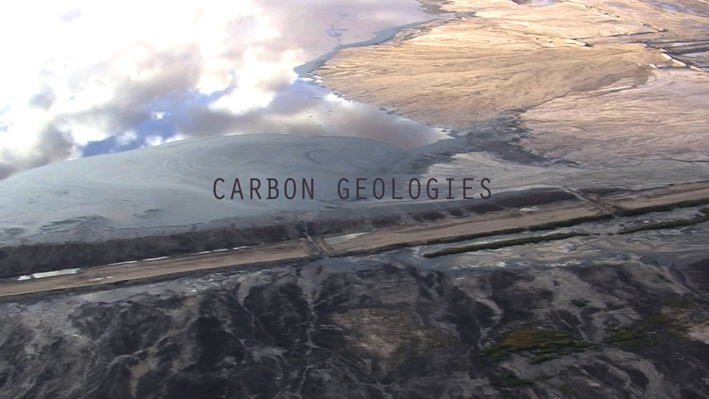
Still from Deep Weather (2013), Fields of tar sands of Alberta, Northern Canada.
Andrew Pendakis: I want to begin by asking you a very general question about the aesthetics of what we might call primary substances, those materials or liquids, like oil, water and coal, which come to peculiarly mark or subtend the cultural structure of an economy. I am interested particularly in those substances which we are tempted to imagine vertically at the bottom of things, the floorboards or groundwork of any given historical period or locale. Both water and oil would appear to be candidates here: the first, indispensable, structural, perhaps, in a manner wholly unto itself, the very ur-liquid of life; the second, a basic condition of modernity, essential, but ‘artificially’, as the element necessary less for life itself than life lived under the conditional second nature of industrial capitalism. In what sense can we speak about an aesthetics of oil cultures, a set of recurring spatial, infrastructural, or architectural motifs, for example, or even a dominant structure of feeling or experience which seems to pass through the very molecules of a whole historical reality? Is there an aesthetics of oil or are its cultural manifestations too diverse and localized to be usefully generalized?
Ursula Biemann: Water has traditionally been associated with specific cultural or symbolic meanings, so it is hard to generalize the aesthetic dimension of this life-sustaining liquid. But oil is an entirely different case: it has literally propelled humanity into a different era of mobility and consumption. Hydrocarbon society is rooted in a concrete moment of discovery–it has a specifiable beginning – and an end! It has engendered the whole universe of plastic culture. We usually do not associate crude oil with the vast number of new substances and objects which have entered our lives as products of petrochemistry. In our minds, the preciousness of oil is more closely linked to petrodollars: it is a political substance. Apart from geopolitics and its inevitable spatial tropes – and that is certainly a major problem in the representation of oil – as a mineral resource, the discourse that shapes the image of oil is articulated in economic and industrial terms: it is, in other words, very much a corporate substance as well. Corporations are hyper sensitive when it comes to their public image, they are very careful in controlling visual representation. There is always some pipeline patrol lurking on the horizon, ready to charge down the hill and prevent you from filming. So we ended up with an aesthetic that essentially foregrounds the gigantic investments in the infrastructures necessary for extraction and evacuation, as well as their spectacular failures. The petro-era coincides with a period marked by technology and hardware; it seems that culturally speaking it has already come to an end.
Pendakis: I think you are right that our conception of oil is usually oriented by this wide-angle image of the silently running oil refinery or platform. Oil is, in this sense, dangerously literalized, wrongly conceived as simply coextensive with a highly simplified figure of its own productive apparatus. What do you think is screened out by this image? Also, I am intrigued by this invocation of “plastic culture”. Might this be a kind of shorthand for our moment’s particular relation to oil? It is true that it seems the ‘age of oil’ is coming to an end, not in the literal spectre of Peak Oil or some kind of imminent shift to a new primary energy source, but in the sense that oil seems to chug into the present like an echo from the nineteenth century. The roar of the combustion engine feels quaintly modernist, almost embarrassingly promethean and earnest when viewed from the angle of the silent and immobile microchip. Could you speak more about this paradoxical end to (or transformation within) a certain dominant era of petro-culture?
Biemann: I see this level of abstraction in the representation of oil as yet another way to keep it firmly in the hands of market dynamics, a remote and inaccessible entity, supposedly too big and complex to grasp for the average citizen. What does not come through in these repetitive stencils of oil related images is the regional histories and local textures of interaction between infrastructures and social communities, the thorough reorganization of cultural alliances and political forces on a regional level, the relocation of populations as a result of big money flowing into an impoverished area and the non-democratic decision-making processes of regimes involved in these deals as well as the impressive epistemic apparatus that is set into motion by the conception of big infrastructure projects. All these dynamics affect large populations one way or another. To begin by giving these ephemeral processes some form of visual presence, is a way to start filling in the missing elements.
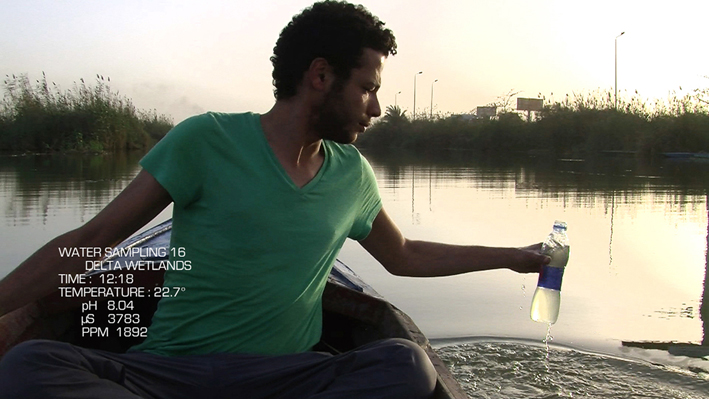
Still from Egyptian Chemistry (2012) taking of water samples in the Nile Delta.
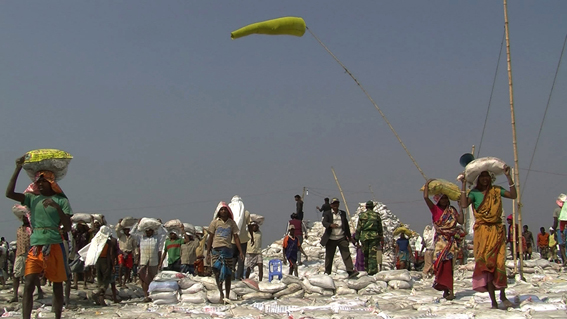
Still from Deep Weather communal embankment building in the Bengal Delta.
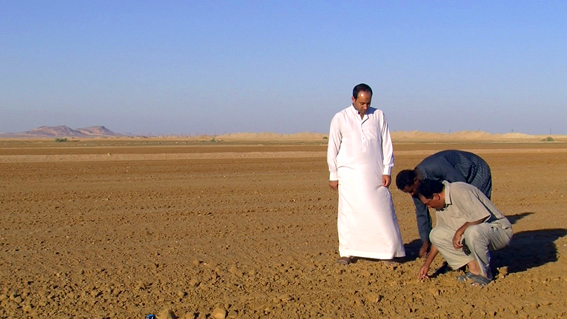
Still from Egyptian Chemistry (2012) Desert development project on the Upper Nile
The discovery of the vast potential of oil for the creation of new materials mustering an extraordinary range of qualities has fueled our imagination to create a synthetic world and overcome natural limits. This fact is probably just as important for the understanding of who we are today as the mobilization and substitution of labour power facilitated by the combustion engine itself. It seems to me that humanity has jumped ahead in out-of-synch rhythms. While it advanced its material sophistication to a high degree, the engine remains sadly stuck in the 19th century and yet we still invest huge resources into building infrastructures for a system we know is long outdated. But I sense there is another connection there that would be important to understand better. The ability to chemically synthesize the world and thus create its artificial extension has simultaneously triggered an imagination of nature and its relation to the human subject. This bizarre construction of nature as something separate from us is what makes the gigantic ecological devastation of petro-culture possible.
Pendakis: Oil and water, though not quite opposites, are anecdotally understood as chemically incompatible (‘they don’t mix’). This incompatibility mirrors a very strong associative or symbolic antagonism. Oil is arguably the dirtiest of liquids, ‘the devil’s excrement’, not just on the level of its (highly racialized) material properties (its blackness, its stickiness, its opacity, etc.), but on the terrain of its social and political usage. Sociologists have long noted the ways in which reserves of oil have a way of evolving into inflexible or brutal state structures (layers of corrupt officials and bureaucracy) even as they engender uniquely consumerist life-worlds, populations habituated to expect an inexhaustible and ‘labourless’ flow of automobiles, luxury goods, etc. Water seems to come from an utterly opposed moral universe. Linked to ablution, sustenance, openness, transparency, purity, etc water is the liquid of transcendence, but also the most modest and common of social goods. This opposition has been dramatically compromised by the increasing commodification of water and the emergence of huge conglomerated interests in the profits available to those who own and market it. How do your works attempt to navigate the existing infrastructural realities of oil and water in the light of these moral geographies? Do you prefer to work within these inherited meanings as a way of mobilizing an audience politically or aesthetically or should the artist instead try as hard as possible to have done with moral rhetorics premised on lost purities or ‘nature’?
Biemann: Rather than looking at oil and water in these essential and nominally opposed terms, I have investigated the environment they each tend to generate in conjunction with human, social and technological entities and these are highly situational. I would refrain from assigning symbolic meaning to the substance itself. As a corporate capital-intensive fluid, oil tends to create top-down power structures. It is a deeply anti-democratic substance in that governments, which are thriving on large incomes from fossil resources, have no need to consult their taxpayers to make political decisions: they don’t need a people. States like this are like a head without a body, they are bound to create autocratic regimes. However, there are subtle and brutal processes, both of which are important to show. When I began my research on oil for Black Sea Files about ten years ago, there was hardly any cultural theory and very few aesthetic productions on the topic. It would have been inconceivable then to organize a conference on petrocultures, since the signification of oil beyond the economic and geopolitical dimension was largely unarticulated. I wish there had been books available then like Reza Negarestani’s Cyclonopedia who creates a fantastic vocabulary around this dark lubricant and narrative undercurrent of all politics and ethics of life on earth. Without such inspiring prose, I practically had to start from scratch. But what I noticed during my research is that there is a considerable discrepancy between the explanatory heart of energy geography in urban centers and at the campuses, and the messy, remote and unstable resource fringes where these situations take place. There is a center/periphery dynamic set up between the cores of theory building and the social struggles around the extraction zones. If anything, I see it as my moral obligation to keep establishing the links between them, even at the risk of placing this very process again at the center.
It has become obvious that ecological devastations go hand in hand with the existential struggles of marginalized communities. Deep Weather, the video shown at the Maldives Pavilion in Venice, makes this inherent correlation evident by connecting the dark open pit extraction zone for tar sands in the midst of the vast boreal forests of Northern Canada, with the struggles of Bangladeshi communities protecting their Delta villages from rising Sea levels. Hands on work by thousands without any mechanic help is what climate change will mean for people in the Deltas of the global South and elsewhere. In this accelerated world, the two operations collapse in time.
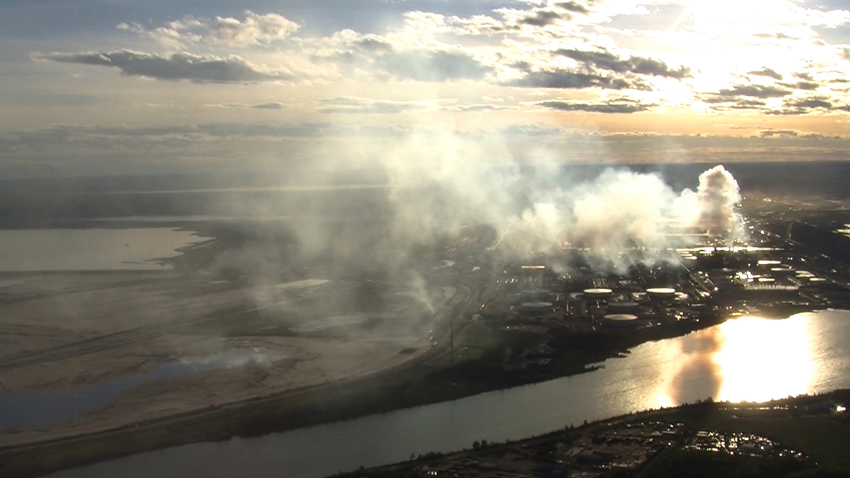
Still from Deep Weather (2013), Fields of tar sands of Alberta, Northern Canada.
But my ongoing concern with the human geographies of hydrocarbon society doesn’t mean that I’m disinterested in the molecular level of how reality constitutes itself through water and oil and a million other things. Interesting that you would mention the chemical reaction between these distinct liquids, since in chemistry, substances are characterized entirely by their willingness to bond and transform into new compounds. Both water and oil are made of hydrogen, when combined with oxygen we get water, when combined with carbon we get oil, each opening up a different arena of bonding opportunities. The interaction with one another might be repulsion, but that is still a strong relation, if in the negative. We should be looking for the chemical substance common to blood, plants and petroleum and we would find that we share a high degree of DNA.
The problem I see with highlighting the cultural value of water by foregrounding its symbolic virtues is that we continue along the line of an economistic thinking that assumes that anything which has a value requires some sort of compensation. It firmly remains within a human-centric vision of culture. Even before the calamity of bottled water, any hydraulic infrastructure, any dam, barrage or irrigation canal, prepares the ground for the commodification of water. By processing and facilitating water, it automatically becomes something that can be charged for. States have begun to take into account what they call virtual water, i.e. the water needed to produce something, whether it be a computer chip, roses or a barrel of oil gained from tar sands. By importing water-intensive products, a state can save a lot of its own water. The shadow side is that poor countries cannot afford to relinquish these incomes. They deploy their modest water resources for export cultivations. Water scarcity in the south is also a product of importing countries.
With World of Matter, a collaborative art and research project on resource geographies I’m involved in, a number of stakes start to emerge. We have compiled them in a workbook Provisões /Provisions that we launch at the opening of the Maldives Pavilion. A central issue is to make natural resources a matter of public debate and decision-making rather than leaving it to market dynamics. The question here is how we can engage in aesthetic productions that will make commodities more transparent and accessible to public knowledge. Another point that you just mentioned is to problematize the notion of nature and do away with an anthropocentric perspective on the world whereby everything is turned into a resource for humans. This is deeply linked with the act of representation as a way to shift the discussion from the object of oil, water or gold to the cultural meaning the stuff has for us. The frantic use of global resources goes hand in hand with an accelerating process of over-signification, not least through cultural studies or the tendency to open aesthetic and cultural discussions to fields that have been hitherto subjects of economic-industrial discourses or natural science. These are some of my most urgent concerns: how can I image resource issues in ways that are both signifying and a-signifying. Whether we assign pure and spiritual qualities to water or devilish ones to oil makes no difference, the problem is with representation itself.
Pendakis: You referred above to the omnipresent “pipeline patrol” and this issue of policing touches upon another question I would like to pursue. We are unquestionably living in an age of secrecy, an age in which, one might say, the secret has gone structural. The insider’s stock tip, offshore accounts, classified production facilities, ‘creative accounting’, the research records of pharmaceutical companies: secrets populated earlier societies, and they were perhaps always in some way ‘functional’, but there is a way in which the hidden has become conscious, a basic requirement of the production and reproduction of capitalist economies. Catherine Malabou speaks of the way neurobiological processes are structurally invisibilized in the process of creating the transparency of consciousness; Karl Marx’s own work would seem to echo this on the level of production, positing an order of the invisible which renders possible the liberal vista and its life-world. In Black Sea Files you purposively travel to the Southern Caucasus to visually research the construction of the Baku-Tblissi-Ceyhan pipeline; it is as if your objective was to literally capture this mechanism of flow before it was interred permanently into a domain of invisibility and silence. How does your work travel along this thin line between unveiling the hidden and respecting the complexity and opacity of things? Given the epistemological obsessiveness of your work, how does one reveal without blundering into the territory of absolute transparency? What can you tell us about this process or about your thoughts on the dialectic between seeing and hiding in modern or postmodern economies? What role does secrecy or hiddenness play in the political economy of oil itself?
Biemann: Are you alluding to the idea that infrastructures are most powerful when they are invisibly operating in the background, hidden from our consciousness? Well, the only way to capture the moment of the giant effort necessary to build such an invisible power structure is by filming the actual construction of this crude oil corridor clearing the access far into former Cold War territory. There is something to be gained from visually mapping these procedures in the most diverse way possible, challenging the monological narration based on technological pioneering. To offset the linear master narrative provided by oil corporations I instead install a loose cartography of multiple voices uttered by migrants, peasants, fishermen, prostitutes, oil workers and the like who intertwine with the pipeline. The powerful impact of invisible structures is true, of course, not just for energy but also, very prominently, for the media apparatus. What is kept in the hidden realm is what’s not considered to be of immediate world interest, which is almost everything. What is shown is merely a selected narrow vision. I see the problem not so much in the incorrect representation but in the selection process itself and the pretense to bring clarity via this scripted formula of news writing, when in my experience, the production of knowledge on site is an immensely confusing and fragile undertaking. In an interview with two sex workers in the presence of their pimps and agents, I attempt in Black Sea Files to make the emergence of misunderstanding more transparent.
The essayist video format with its diverse image sources, scrolling text and voice-over narration generally tends to stack multiple layers of meaning and interpretation, none of which pretend to be a stable, exclusive representation of reality. On occasion, I even weave myself into the process by reflecting on my practice as an undercover agent to find hidden, secret knowledge and in the process turning into an embedded artist who operates in the trenches of geopolitics. All this is acknowledging the subjective and often subversive dimension of artistic fieldwork that is more closely related to secret intelligence than, say, to anthropology.
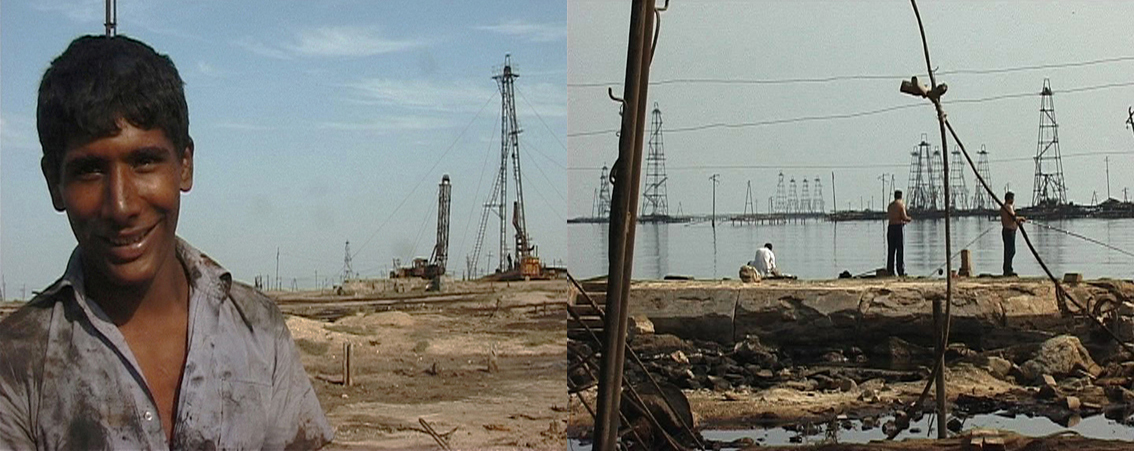
Still from Black Sea Files (2005) Bibi-Heybat oil fields near Baku, Azerbaidjan
Pendakis: As I alluded to above your latest work appears to be focusing less on oil proper and more on the human (and in- or non-human) geographies of water in an age of climate change. And yet there remains a great deal of continuity here: transformations in the viability of global water are only the flip-side of our dependence on fossil fuels, the perverse externality of oil’s central location at the heart of our societies. In your video Deep Weather, we are presented with an opening shot that almost appears to arrive unfiltered from the origins of stabilized agricultural civilization itself. Approaching from the sea, the camera captures a seemingly infinite line of wriggling human motion, a continuous flow of Bangladeshi workers dragging bags of mud to shore up and secure a barrier they hope will prevent their communities from being flooded by rising waters. This is a primeval image, one resonant with echoes from the original domestication of the Nile and other such ‘cradles of civilization’. In such moments, you seem to be working in a mode that transcends or transmutes realist documentarity, one imbued with a sense for anthropological invariance, the repetitions of cyclical time, even a poesis conceived of as co-extensive with nature itself. I sense a very similar set of concerns in the fragments I have seen from your current project, Egyptian Chemistry. Here again past and present seem bound in a space/time that defies the illusion of their separation, one which draws on myth (without devolving into holism or apoliticism), but also on science or sociology (without giving into determinism or a too-simple empiricism). Am I wrong to think you are trying to invent videographically a new form of universality, one that is fragile, plural, ragged, full of holes, yet somehow coacervated by the muddy oneness of the planet itself? I discern in your work the lineaments of a very interesting materialist universality, one which confidently draws on scientific naturalism, the methodologies of the social sciences (especially ethnography), but also on poetry, aesthetics, and the mythic imagination without stumbling into incoherence or eclecticism.
Biemann: This unspeakable image of thousands of villagers building a giant mud embankment entirely by hand without any mechanical assistance is what derailed climate patterns and melting ice fields will mean for many of us on earth. The image speaks of the primeval need for safety from extreme weather events and floods and of the futility of believing we could protect life on the planet with ridiculous technological measures. Part 1 of the video, by the way, is shot in the toxic tar sands of Alberta where the dirtiest of fossil resources is being extracted that will no doubt continue to impact on the living conditions of populations on the other side of the earth. We are speaking of a terrestrial scale here. When we have been thinking in global dimensions over the last two decades, this is the time to go planetary. And this shift requires a whole new vocabulary, both visual and verbal. Geography as a theoretical platform for tackling global issues such as migration networks, supply lines or communication infrastructures, turns out to be insufficient, or simply too flat, for this enlarged dimension because it falls short of grasping the depth of many dawning questions such as species survival and the transformation of the biosphere. So my new images intend to evoke temporal depth by returning to moments prior to the industrial revolution with its frantic dam building activity, and to scientistic knowledge with its partition into disciplines and infinite sub-disciplines. It is this alchemist approach of raising metachemical and philosophical concerns, perhaps, that imbues the video with a mythic imagination. Al Khemia (Arabic for chemistry) also happened to be the ancient word for Egypt, meaning the Black Land, possibly due to the dark muddy Nile floods periodically covering the land. The term alludes to the vision that, before anything else, the earth is a mighty chemical body, a place where the crackling noise of the forming and breaking of molecular bonds can be heard at all times. So when documenting vast land reclamation projects in Egypt, beyond a comment on technocapitalism, it is first and foremost a videography of the conversion of desert dust into soggy fertility.
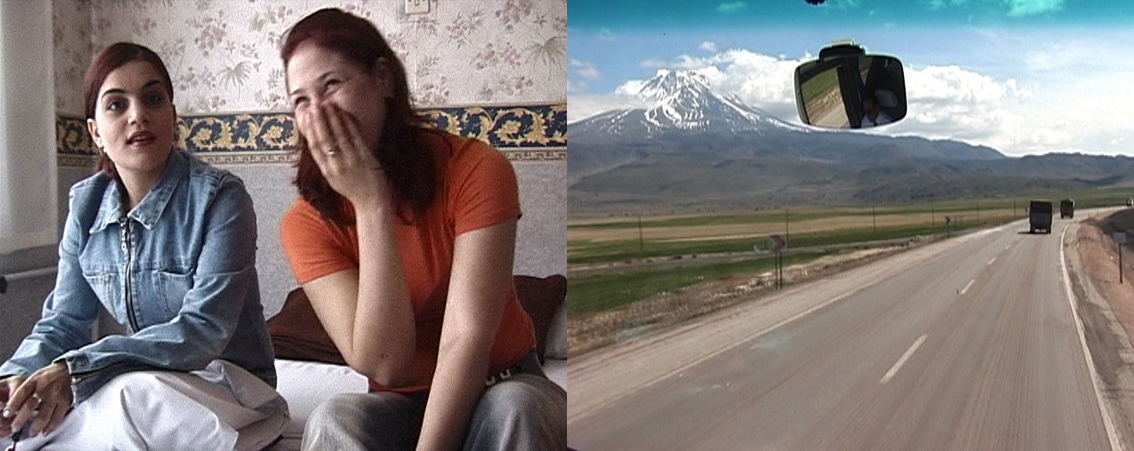
Still from Black Sea Files (2005) Jula and Nara in Turkish border town Trabzon
So yes, I would love to think that I am inventing videographically a new, if flawed and ever morphing sort of universality through the meddling with the muddy materiality of the Earth itself. Incidentally, for Egyptian Chemistry I took a number of water samples from the Nile, so the project is not about making images only. I’m not primarily focusing on strategies of representation, it also contains objective reality. I have come to realize that if we solely attempt to culturalize the discourse on the physical and chemical transformations our planet is currently undergoing by prioritizing meaning and representation, we fail to address a deeper problem. For if we are to speak about the non-human world — weather patterns, organic pollutants, copper atoms — it will not suffice to deploy an anthropocentric discourse. Not everything comes into being through human intention, we need to examine the ways in which human and non-human realities emerge together in a variety of formations.
Rather than through a particular set of criteria, this is more likely to happen through the hybrid consciousness engendered by the assemblage of technological, social and natural stuff, where some elements signify, others not. Metachemistry grasps this turbulent instance of physical and epistemic change, or lineament, as you call it, and propels us into a slightly altered dimension that can only be invoked mythically through space travel, time barriers and the interbiospheric mobility of species.
The multimedia platform is launched in October 2013, www.worldofmatter.net
Videos, curatorial projects and publications by Ursula Biemann, www.geobodies.org


